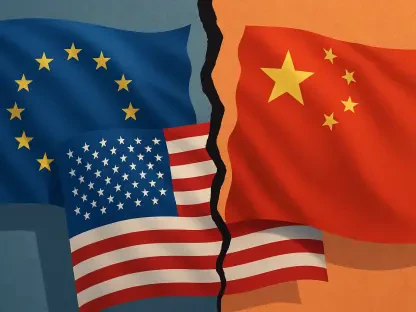Imagine a world where international transactions, once bogged down by high fees and days of processing, are completed in mere seconds for pennies, thanks to the innovative power of stablecoins. These cryptocurrencies, designed to maintain a steady value by being pegged to assets like the U.S. dollar, promise efficiency but come with significant risks if left unregulated, potentially destabilizing financial markets. Enter the Guiding and Establishing National Innovation for U.S. Stablecoins (GENIUS) Act, a groundbreaking piece of legislation in the U.S. Congress aimed at taming this wild frontier of digital finance. This review dives deep into the technology behind stablecoins and the regulatory framework proposed by the GENIUS Act, assessing its features, implications, and potential to shape the future of global trade.
Core Features of the GENIUS Act Framework
Reserve and Transparency Standards
At the heart of the GENIUS Act lies a stringent requirement for stablecoin issuers to maintain 100% asset coverage, ensuring every digital token is backed by an equivalent value in stable assets like cash or government securities. Unlike traditional banking systems, which often operate on fractional reserves, this full-backing mandate aims to eliminate the risk of runs or insolvency during market turbulence. Such a measure is designed to instill confidence among users, positioning stablecoins as a reliable alternative to volatile cryptocurrencies.
Beyond asset backing, the Act imposes rigorous transparency protocols. Issuers must undergo regular audits and verifications to confirm compliance, with a structured 18-month implementation timeline following enactment to align with federal and state regulations. This focus on clarity seeks to prevent opaque practices that could hide financial vulnerabilities, drawing a sharp contrast to past financial crises where lack of oversight played a central role.
Oversight and Accountability Structures
The GENIUS Act also establishes a robust oversight mechanism to monitor stablecoin providers, requiring consistent reporting to regulatory bodies. This framework is crafted to safeguard investors by ensuring issuers adhere to strict operational standards, minimizing the likelihood of mismanagement or fraud. By placing accountability at the forefront, the legislation addresses concerns over market stability in an industry often criticized for its lack of governance.
Additionally, the Act’s emphasis on regulatory supervision mirrors lessons learned from historical financial breakdowns, where insufficient checks led to widespread economic damage. The proposed structure aims to create a safety net, balancing the innovative potential of stablecoins with the need to protect the broader financial ecosystem from systemic risks.
Performance and Economic Implications of Stablecoins Under Regulation
Transformative Applications in Trade
Stablecoins, when regulated under frameworks like the GENIUS Act, hold immense potential to revolutionize international trade. By leveraging blockchain technology, these digital assets can slash transaction costs dramatically, often reducing fees from dollars to cents. A practical example can be seen in a manufacturing hub in Colebrook, New Hampshire, where regulated stablecoins facilitate low-cost, stable payments for operations using sustainable energy inputs, showcasing real-world efficiency gains.
Moreover, stablecoins offer a gateway to financial inclusion, particularly for the billions of unbanked individuals worldwide. With minimal infrastructure requirements, these digital currencies enable access to global markets, allowing underserved populations to engage in commerce without traditional banking barriers. This democratizing effect highlights stablecoins as a tool for economic empowerment, provided regulation ensures their reliability.
Challenges in Scalability and Market Risks
Despite their promise, stablecoins face significant technical and market hurdles that the GENIUS Act must navigate. Scalability remains a concern, as blockchain networks underpinning these tokens often struggle to handle high transaction volumes without delays or increased costs. Additionally, the risk of poorly managed or unregulated stablecoins persists, potentially leading to market disruptions if issuers fail to maintain asset backing.
Regulatory challenges also loom large, with compliance costs posing a burden on smaller issuers and differing international standards complicating global adoption. The GENIUS Act’s success will depend on its ability to address these performance gaps, ensuring stablecoins can scale effectively while maintaining user trust through consistent oversight.
Global Context and Competitive Landscape
Comparison with International Regulatory Efforts
The GENIUS Act does not operate in isolation; it is part of a broader global push to regulate stablecoins. The European Union’s Markets in Crypto-Assets Regulation (MiCA), effective since late last year, similarly mandates 100% liquid reserves and strict transparency for stablecoin issuers. While both frameworks share a commitment to consumer protection, differences emerge in market focus, with MiCA targeting Euro-based stablecoins and the GENIUS Act prioritizing U.S. dollar-backed tokens.
Notably, some major players like Tether have opted to sidestep MiCA compliance, highlighting the fragmented nature of global regulation. This divergence underscores the need for harmonization, as varying standards could create loopholes or competitive imbalances. The GENIUS Act’s ability to align with or influence international norms will be critical to its long-term impact on digital finance.
Geopolitical Dynamics and Currency Dominance
Stablecoins are not just a technological innovation; they are also a battleground for geopolitical influence. The dominance of the U.S. dollar as the global reserve currency gives dollar-based stablecoins a head start, potentially overshadowing Euro-based alternatives if U.S. trade policies remain stable. However, ongoing tariff disputes and deficit spending could erode this advantage, opening the door for competitors like the Euro or even the Chinese renminbi.
The rise of the BRICS economic bloc, representing a significant portion of global GDP, adds another layer of complexity. With increasing trade in non-dollar currencies, the landscape for stablecoins could shift, challenging U.S. leadership in this space. The GENIUS Act must consider these dynamics to ensure dollar-backed stablecoins retain their edge amidst evolving global economic trends.
Final Thoughts and Path Forward
Looking back, this exploration of the GENIUS Act and stablecoin technology revealed a landscape brimming with opportunity yet fraught with challenges. The legislation’s robust reserve requirements and oversight mechanisms stood out as vital steps to secure user trust, while stablecoins themselves demonstrated transformative potential in trade and financial inclusion. However, scalability issues and geopolitical tensions underscored the hurdles that remain unresolved.
Moving ahead, stakeholders should prioritize fostering international cooperation to standardize regulations, preventing a patchwork of rules that could stifle innovation. Policymakers must also invest in blockchain infrastructure to address performance bottlenecks, ensuring stablecoins can handle growing demand. Finally, a keen eye on global economic shifts will be essential to adapt the GENIUS Act’s framework, safeguarding U.S. interests in an increasingly competitive digital currency arena.









